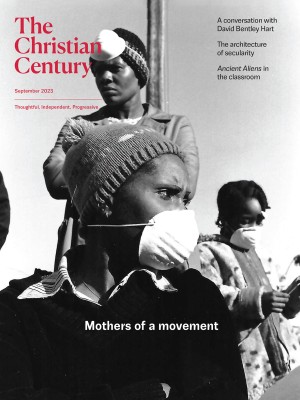Catharsis at church
The book of Ezra helped me realize how bad most congregations are at handling big emotions.

Century illustration
“You need to let that out.” I remember my therapist saying these words. I remember because it was the first time in our years together that they cut the “I get you to talk / you figure it out” bit and flat out gave me some advice. This happened years ago, but I still remember, as if moments ago, those words and the emotions they were speaking to: frustration at disappointments recent and aged, anger I had been so afraid to get in touch with, and deep sadness I had found a way to “busy” myself through. All of these were there, lurking, as long-held emotions do, and beginning to seep into my ministry.
I found myself less patient with staff, a bit angrier from the pulpit (and not in that “prophetic fire” kind of way), far more cynical, and just so tired. Your body may be different, but mine’s way of telling me something is to make me tired. Even though I could sleep like a teenager well into my 30s, I knew something was off. And to my therapist’s credit, they had known long ago and were risking their laurels to commit an act of grace.
Read our latest issue or browse back issues.
“You need to let that out.”
The word is catharsis: to let go of an emotion that is tied to a traumatic event but has been repressed. That’s the fancy definition; here’s mine: catharsis is when you drag that thing up and let that thing out.
There are things we need to let out that will ruin our health and our ministries if we don’t. Note the plural we. For all the internal cleansing I’ve been doing—the Greek katharsis means “purification”—it occurs to me that most faith communities are terrible at doing this as a collective. I don’t even think most congregations see themselves as safe spaces for catharsis, but I’ll tell you what opened my mind: the book of Ezra.
That strange little book. The one where Ezra calls up all the foreign-born women and biracial children and casts them out of the community. (Right after coming home from exile, he makes exiles.) The book so difficult to interpret for Christian life that it doesn’t appear once in the three-year lectionary cycle. The Ezra narrative needs more than this article can give, but there’s a moment, as the Second Temple’s foundation is being laid, when everyone is shouting and praising God—but the elders who saw the temple in its former glory are weeping, weeping so loudly that you can’t tell the shouting from the weeping (3:12–13).
Reading this smashed me in the face. Here are these people, who have left and come back, on old bones that have seen glory and destruction, and now they are building their temple again. For 50 years they have felt every possible emotion and needed to hold it in for their own survival, and now they finally have a chance to let it out. How messy it must have been! How freeing it must have felt!
And what stuns me most is that these aren’t separate, private little catharses happening; they’re all doing it together. This is a communal catharsis, it’s happening as part of the community’s life and not distinct from it, and at no point are people rebuked for it. The storyteller doesn’t even pause to acknowledge it as anything extraordinary: It’s just what we do.
But in the church, that’s not at all what we do. Not even close. People feel long-held emotions that they need the space and permission to let free, as part of their own journey to freedom. But many church spaces don’t feel like safe places to do this. Imagine your congregation and what would happen if someone came this Sunday and began crying so loud it sounded like shouting. What would we say to them? What would we say about them?
Our churches are not situated well to handle big emotions, even though we deal daily in the stuff that conjures them. And when things happen to us as a community—like pandemics or pastoral abuses or things we try that fail miserably—we feel big emotions collectively. Hurt, sadness, anger: all of that and then some. Yet our road back to “normal” rarely includes some sort of moment to collectively praise and weep and shout. What trauma do our communities still hold because we have moved too quickly into praise? What crucifixions have we not held properly in our rush to proclaim resurrection for ourselves?
I’ll raise my hand and admit to rushing into “Hey, we’re OK!” even though it brings me great shame, knowing that I come from and remain faithful to the Black church. Though not a monolith, the Black church was born out of the desperate need for communal catharsis, and it remains the yelling, stomping, shouting nerve center of catharsis in the church universal. If there is anything to be learned about providing safety and permission to perform a liberative, subversive emotional act, it is to be learned from Black people in America. Such acts are replications of healing spaces that trace themselves throughout history and, although neglected, remain part of our faithful practice.
Sometimes we tell ourselves that if we are not yelling, then we are OK. Catharsis teaches us that the opposite is true. We need messy moments as part of moving forward together as a community. Because we know that what is messy can also be cleansing. And we know that even though we stopped talking about it, it hasn’t gone away.
We need to let that out.






